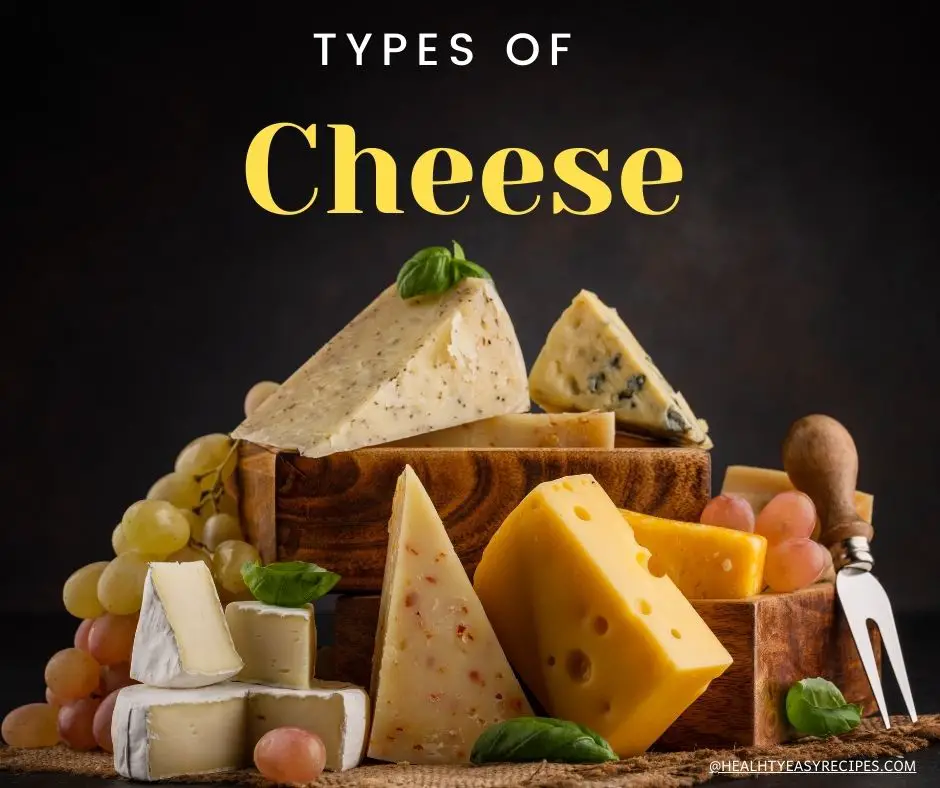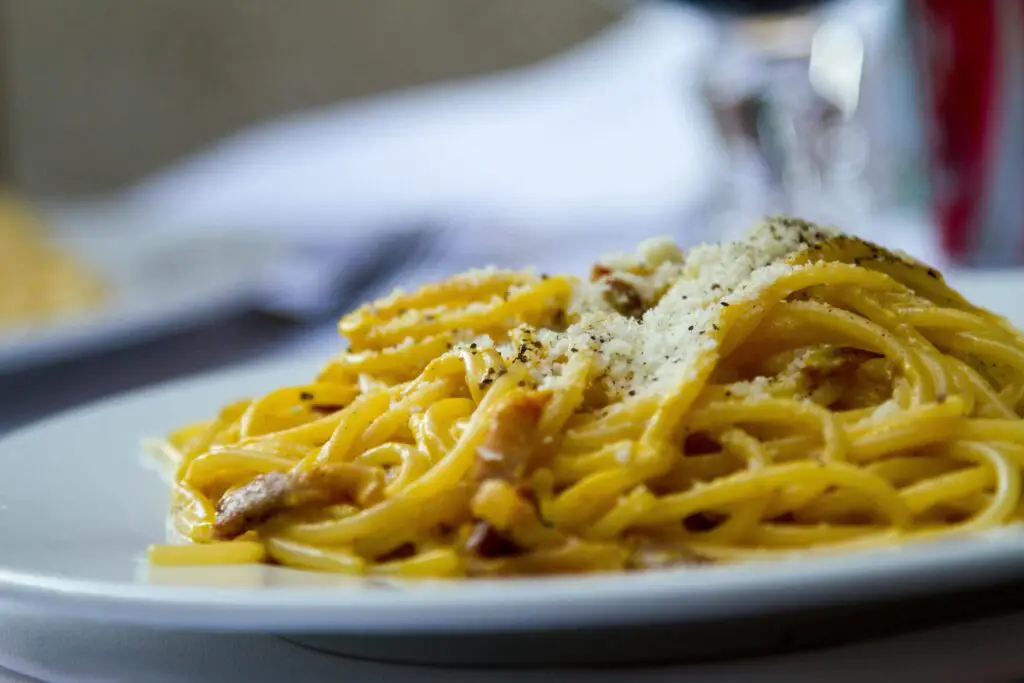30 Different Types Of Cheese: Recipes & How To Use Them
This guide introduces 30 different types of cheese from around the globe. Cheese is one of the most beloved and versatile foods in the world, with a history as rich and diverse as its flavors. From creamy and mild to sharp and tangy, the sheer variety of cheeses can elevate any dish or be enjoyed on its own. Whether you’re a cheese enthusiast or just curious about the many types available, discover their unique textures, flavors, and culinary uses, and get ready to expand your appreciation for this timeless delicacy!
Cheese, a beloved dairy product, boasts a rich history and diverse production methods that have evolved over millennia. From ancient preservation techniques to modern artisanal practices, cheese continues to captivate palates worldwide.
A Brief History of Cheese
The origins of cheese trace back over 7,000 years, with evidence suggesting its accidental discovery by storing milk in animal stomachs, leading to curdling due to natural rennet. Archaeological findings, such as 7,200-year-old cheese-making residues on the Dalmatian Coast, highlight its ancient roots. Throughout history, cheese-making has been documented across various civilizations, including ancient Egypt, Greece, and Rome, each contributing to its development and diversification.
The Cheese-Making Process
Cheese production transforms milk into a myriad of textures and flavors through several key steps:
- Milk Selection and Preparation: Cheese can be made from the milk of cows, goats, sheep, or buffalo. The process begins by bringing the milk to a specific temperature to promote the growth of beneficial bacteria.
- Coagulation: A coagulant, such as rennet, is added to the milk, causing it to curdle and separate into solid curds and liquid whey.
- Cutting and Cooking the Curds: The curds are cut into smaller pieces to release whey and then gently heated. The size of the curds and the cooking temperature influence the cheese’s final texture.
- Draining and Pressing: Whey is drained from the curds, which are then pressed to form a solid mass. The amount of pressure applied affects the cheese’s moisture content and texture.
- Salting: Salt is added for flavor and as a preservative. This can be done by directly mixing salt into the curds, rubbing it on the cheese’s surface, or immersing the cheese in a brine solution.
- Aging (Affinage): Cheeses are aged under controlled conditions to develop their characteristic flavors and textures. Factors such as temperature, humidity, and time play crucial roles during this maturation process.
Variations in these steps, along with specific bacterial cultures and molds, result in the vast array of cheese types enjoyed globally today.
Understanding the history and production of cheese enhances our appreciation for this versatile food, reflecting cultural traditions and artisanal craftsmanship passed down through generations.
Factors that contribute to the diversity of cheese varieties
The remarkable diversity of cheese varieties available today results from a complex interplay of factors that influence their flavor, texture, appearance, and aroma. Key contributors to this diversity include:
- Milk Source and Composition: Animal Species: Cheese can be made from the milk of various animals, including cows, goats, sheep, and buffalo. Each species of milk has unique fat and protein compositions, affecting the cheese’s flavor and texture.
- Diet and Environment: The diet of the milk-producing animals, influenced by regional flora and climate, imparts distinct characteristics to the milk, thereby affecting the cheese’s taste.
- Microbial Communities: Starter Cultures: Selecting specific bacteria and molds initiates fermentation, influencing the development of flavor and texture.
- Environmental Microbiota: Ambient microbes present in the cheese-making environment contribute to each cheese’s unique microbial ecosystem, affecting its maturation and final profile.
- Production Techniques: Coagulation Methods: Utilizing different coagulants, such as rennet or acid, leads to variations in curd formation and texture.
- Curd Treatment: Cutting, cooking, stirring, and washing curds influence moisture content and texture, resulting in diverse cheese types.
- Pressing and Aging: The degree of curd pressing and the conditions under which cheese is aged (temperature, humidity, duration) significantly impact its firmness, flavor intensity, and rind development.
- Geographic and Cultural Influences: Terroir: The unique combination of local climate, soil, and natural microbial populations in a region imparts specific qualities to the cheese, contributing to its distinct identity.
- Traditional Practices: Cultural heritage and traditional methods passed down through generations play a crucial role in shaping cheese varieties, with specific techniques and recipes unique to different regions.
Understanding these factors provides insight into the rich tapestry of cheese varieties enjoyed worldwide, each embodying a unique combination of natural elements and human craftsmanship.
Here’s a list of 30 different types of cheese from around the world:

1 – Semi-Hard Cheeses
Semi-hard cheeses, including Cheddar, Gouda, and Edam, have a firmer texture and are often aged to develop a more pronounced flavor. They are versatile in culinary applications, suitable for slicing, melting, and grating.
Cheddar
Originating from England, Cheddar is a firm cheese with a distinctive sharp and tangy flavor. It ranges in texture from smooth and creamy when young to crumbly and intense as it ages. Cheddar is one of the most popular types of cheese globally, ideal for sandwiches, casseroles, and as a topping for burgers. Its versatility makes it a staple in both everyday meals and gourmet dishes.

Gouda
Originating in the Netherlands, Gouda is a semi-hard cheese celebrated for its creamy texture and mild, slightly sweet flavor. Young Gouda is soft and creamy, while aged Gouda becomes firmer with a deeper caramelized taste. It’s a versatile cheese, perfect for slicing on sandwiches, melting in recipes, or enjoying with wine and crackers.
2 – Pasta Filata Cheeses
Pasta filata, or stretched-curd cheeses like Mozzarella and Provolone, involve a special process where curds are heated and stretched to achieve a pliable consistency. This technique results in cheeses with distinctive textures, ideal for melting and stretching.
Mozzarella
This iconic Italian cheese is soft, milky, and stretchy, making it a favorite for melting. Traditionally made from buffalo milk, mozzarella has a mild flavor and a delightfully smooth texture. It’s a cornerstone of Italian cuisine, famously used in pizzas, caprese salads, and baked pasta dishes. Fresh mozzarella is often enjoyed with a drizzle of olive oil and fresh basil for a simple yet delicious appetizer.

Provolone
This is one of the types of cheese that is semi-hard, Provolone is known for its sharp, tangy flavor and smooth, firm texture. Depending on its aging, Provolone can range from mild and creamy to robust and piquant. It is commonly used in Italian sandwiches, in baked dishes like casseroles, or melted over meats and vegetables.
Hard Cheeses
Hard cheeses like Parmesan and Asiago are aged for extended periods, resulting in a dense, crumbly texture and an intense flavor profile. These cheeses are commonly grated over dishes to enhance depth and complexity.
Swiss
Known for its iconic holes, or “eyes,” Swiss cheese is a mild and nutty type of cheese that originated in Switzerland. The holes are formed during the cheese-making process by gas bubbles released by bacteria. Its smooth, firm texture makes it an excellent choice for melting in sandwiches, omelets, or as part of a cheese fondue. Swiss cheese is also a popular option for pairing with fruits and nuts on a charcuterie board. This is the typical cheese used in a cheese croissant.

Parmesan
Known as Parmigiano-Reggiano in Italy, this hard, aged cheese boasts a rich, nutty flavor and a granular texture. Aged for at least 12 months, Parmesan is perfect for grating over pasta, soups, and salads, enhancing dishes with its savory depth. This is one of the types of cheese that is delicious when enjoyed on its own, paired with fruits or nuts, or drizzled with balsamic vinegar.

Asiago
An Italian cheese with a flavor that evolves with age, Asiago can be enjoyed in both its fresh, soft form (Asiago Pressato) and its aged, hard form (Asiago d’Allevo). Fresh Asiago has a mild and creamy flavor, while aged Asiago becomes sharper and nuttier. It is often grated over pasta, salads, or soups, or served as a flavorful addition to cheese boards.
Pecorino Romano
A traditional Italian cheese made from sheep’s milk, Pecorino Romano is salty, hard, and intensely flavorful. Its crumbly texture and robust taste make it a go-to choice for grating over pasta dishes like carbonara or cacio e pepe. Aged for several months, Pecorino Romano is also delicious when paired with honey, fruits, or nuts for a sweet and savory contrast.

3 – Soft-Ripened Cheeses
Soft-ripened cheeses, such as Brie and Camembert, are known for their creamy interiors and edible, bloomy rinds. They undergo a maturation process where molds like Penicillium camemberti are introduced, leading to a softening of the cheese from the outside in.
Brie
Hailing from France, Brie is a soft, creamy cheese with a luxurious texture and a mild, buttery flavor. Encased in a white, edible rind, Brie is often served at room temperature to allow its creamy interior to ooze slightly. It pairs wonderfully with fruits, crackers, and a glass of wine, making it a popular choice for cheese boards and appetizers.
Camembert
Similar to Brie but with a slightly earthier and more robust flavor, Camembert is another soft French cheese with a creamy interior and an edible white rind. Its rich, buttery texture makes it a perfect companion to crusty bread and preserves. Camembert is also delicious when baked whole, offering a warm, melty treat that can be shared at gatherings or served as a decadent appetizer.
4 – Semi-Hard Cheeses
Semi-hard cheeses, including Cheddar, Gouda, and Edam, have a firmer texture and are often aged to develop a more pronounced flavor. They are versatile in culinary applications, suitable for slicing, melting, and grating.
Monterey Jack
Originating in the United States, Monterey Jack is a mild, creamy cheese with a smooth texture and a slightly buttery flavor. It melts beautifully, making it a popular choice for dishes like quesadillas, burgers, and creamy sauces. Its subtle flavor allows it to complement a wide variety of ingredients, from fresh vegetables to spicy salsas.
Pepper Jack
A bold variation of Monterey Jack, Pepper Jack cheese is infused with spicy peppers such as jalapeños, habaneros, or chili flakes. This cheese combines the creamy texture of Monterey Jack with a zesty kick, making it perfect for adding heat to dishes like sandwiches, tacos, or nachos. It’s also a favorite for those who enjoy a bit of spice in their cheese boards.
Havarti
This Danish cheese is loved for its buttery texture and mild, creamy taste. Havarti has a slightly tangy undertone and is often flavored with herbs or spices like dill and caraway. Its smooth consistency makes it ideal for melting into grilled cheese sandwiches or pairing with fruits and nuts. Havarti is also a great choice for snacking or serving on charcuterie boards.
Colby
A mild, semi-hard cheese that is similar to cheddar but softer and more elastic, Colby has a distinct orange hue and a creamy, mellow flavor. It is ideal for snacking, slicing for sandwiches, or melting into comfort foods like macaroni and cheese. Colby’s gentle taste makes it a favorite among kids and adults alike.
Fontina
An Italian cheese with a creamy texture and a slightly nutty flavor, Fontina is one of the types of cheese loved for its ability to melt smoothly, making it a perfect choice for fondues, sauces, and baked dishes. Its flavor profile is mild yet rich, with earthy undertones that pair well with meats, mushrooms, and fresh herbs. Fontina’s versatility also makes it a delightful addition to sandwiches and cheese boards.
Gruyère
A prized cheese from Switzerland, Gruyère is known for its rich, nutty flavor and smooth texture. Aged for several months, this cheese develops a slightly sweet and salty taste. Gruyère melts beautifully, making it a key ingredient in classic dishes like fondue and French onion soup. Its complex flavor profile also pairs well with fresh fruit and crusty bread.
5 – Fresh Cheese
Fresh cheeses are unaged and typically have a high moisture content, resulting in soft textures and mild flavors. Examples include cottage cheese, ricotta, and cream cheese. These cheeses are often used in salads, desserts, and spreads.
Mascarpone
A luxurious and velvety Italian cheese, Mascarpone is renowned for its rich, creamy texture and slightly sweet flavor. Often used in desserts like tiramisu, where it provides a smooth and indulgent base, Mascarpone also finds its way into savory dishes such as risottos and creamy sauces. Its versatility allows it to be a star ingredient in both decadent pastries and elegant appetizers.
Paneer
A fresh, unaged cheese originating from India, Paneer is mild and versatile, with a firm texture that holds its shape when cooked. It’s a cornerstone of Indian cuisine, featured in popular dishes like palak paneer and paneer tikka. Since it doesn’t melt, Paneer can be fried, grilled, or simmered in curries, absorbing the rich spices and flavors of the dish.
Queso Fresco
A traditional cheese from Latin America, Queso Fresco is mild, crumbly, and slightly tangy. Made from cow’s milk or a blend of cow and goat’s milk, it is often sprinkled over tacos, enchiladas, and salads. Its fresh, light flavor balances well with spicy and savory dishes, and its crumbly texture adds a delightful contrast to hearty meals.
Cottage Cheese
A fresh, unaged cheese with a mild flavor and lumpy texture, Cottage Cheese is a nutritious and versatile choice. It is often enjoyed as a snack, mixed with fruit, or used as a protein-rich ingredient in salads, smoothies, or baked dishes. This is one of the types of cheese that is creamy yet light in consistency, making it an ideal option for those seeking a healthy and satisfying addition to their meals.
Feta
This crumbly Greek cheese is traditionally made from sheep’s milk or a blend of sheep and goat’s milk. Its tangy, salty flavor makes it a standout addition to salads, pastries, and Mediterranean dishes. Feta’s creamy yet crumbly texture allows it to complement both raw and cooked ingredients, such as olives, tomatoes, and roasted vegetables. Read More about: 8 Best cheeses for an anti-inflammatory diet

Cream Cheese
This soft, spreadable cheese is a staple in many kitchens, valued for its smooth texture and mild, tangy flavor. Cream cheese is a key ingredient in dishes ranging from cheesecakes and frostings to savory dips and spreads. It pairs beautifully with bagels, crackers, and fresh vegetables, and its creamy consistency makes it easy to blend into both sweet and savory recipes.

Ricotta
A fresh Italian cheese made from whey, Ricotta is soft, creamy, and slightly sweet. Its mild flavor and light texture make it a favorite for both savory and sweet dishes. Ricotta is commonly used as a filling for pasta dishes like lasagna and ravioli, as well as in desserts such as cannoli and cheesecake. It’s also delicious spread on toast with a drizzle of honey or olive oil.

Manchego
A celebrated Spanish cheese made from sheep’s milk, Manchego is aged for varying lengths, giving it a range of flavors and textures. Younger Manchego is creamy and mild, while aged Manchego develops a firmer texture and a more pronounced, nutty flavor. Its distinct taste makes it a favorite on cheese boards, paired with quince paste, olives, or a robust red wine.
6 – Blue Cheese
Blue cheeses, such as Roquefort and Gorgonzola, are characterized by blue or green veins of mold, which impart a sharp, tangy flavor. The unique veining is achieved by introducing Penicillium cultures during production.
Known for its bold, tangy flavor and characteristic blue or green veins, blue cheese is a category that includes varieties like Roquefort, Stilton, and Gorgonzola. These cheeses are aged with Penicillium mold, which gives them their distinctive taste and creamy texture. Blue cheese is perfect for crumbling over salads, melting into sauces, or enjoying with honey and nuts for a sweet-savory treat.
Cheese is a world of endless flavors, textures, and culinary possibilities, with each variety bringing something unique to the table. Whether you prefer the sharp tang of aged cheddar, the creamy indulgence of Brie, or the crumbly saltiness of Feta, there are types of cheese for every palate and occasion. Exploring these 30 different types of cheese not only broadens your taste horizons but also inspires creativity in your cooking and entertaining. So the next time you shop or plan a meal, consider trying new types of cheese to elevate your dishes and delight your senses!
Do you know more types of cheese? Leave a comment below!!








